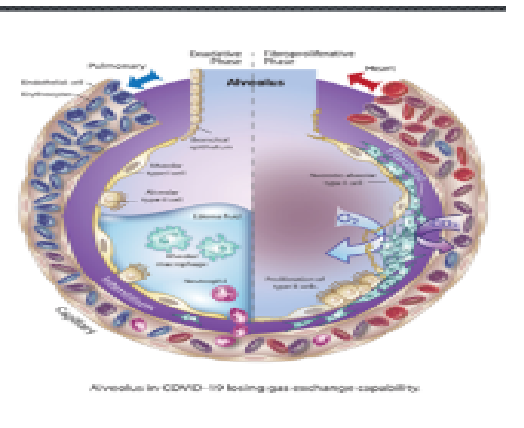Potential Use of Cellular Stromal Vascular Fraction In Post-COVID-19 Pulmonary Injury and Adult Respiratory Distress Syndrome Overview of COVID-19 Lung Damage
Abstract
A coronavirus (nCoV-2) has caused a worldwide pandemic, beginning in Wuhan, China. Patient’s acquiring viral infection (COVID-19) which is often featured by elevation of temperature (>100.3 F°), cough, severe fatigue, and a variety of symptoms mimicking the flu and pneumonias. This gradually may extend to a progressive and serious respiratory failure with associated ARDS-like status and severe pneumonias with residual scarring of the interstitial areas of the lung alveoli, resulting in acute life-threatening, and permanent compromised gas exchange. Those that survive with controlled ventilation (low tidal volumes), medical induced coma, and prone positioning, are often left with reduction in pulmonary function abilities. This paper reviews some pertinent knowledge and advances in understanding of the pulmonary injuries and long-term damage of the COVID-19 patients, and reports a study to ameliorate such damage with use of cSVF for those who successfully recover.
There now exists technology to perform sophisticated analytics (Functional Respiratory Imaging, FRI) developed by Fluidda (Belgium, EU) which provides great detail and information, including the ability to help triage the infected patients early to help assist in prediction of ventilation and ICU needs. In addition, author’s experience with use in Chronic Obstructive Pulmonary Disease (COPD) and Fibrotic Lung Diseases, the ability to evaluate effectiveness of use of cellular Stromal Vascular Fraction (cSVF) following intravascular deployment of isolated and concentrated cSVF. The hypothesis is that reduction of the widespread pulmonary inflammatory and immune responses which destroy much of the gas exchange abilities in the acute and residual damage which appears to create a long-term problem in the surviving patient population. Fluidda imaging analytics, coupled with standard pulmonary function studies, are effective at predictive studies which may prove of great help in anticipating which patient group is at most risk in the earlier infections to require ICU and potential ventilation needs.
Use of Stromal Vascular Fraction Cells (cSVF) are known to help mitigate damage from severe inflammatory disorders, provide immunomodulation, and promote repair and regenerative effects. The ease of access, simple ability to obtain significant numbers of viable cell elements, and the deployment via intravascular route has proven safe and efficacious in other forms of lung disease, including fibrotic lung disorders.
This paper reviews many of the current issues facing the severely infected Post-COVID-19 patient’s lung compromise, and a therapeutic option which clearly shows promise to reverse some residual damage of the lung and gas exchange functions.
